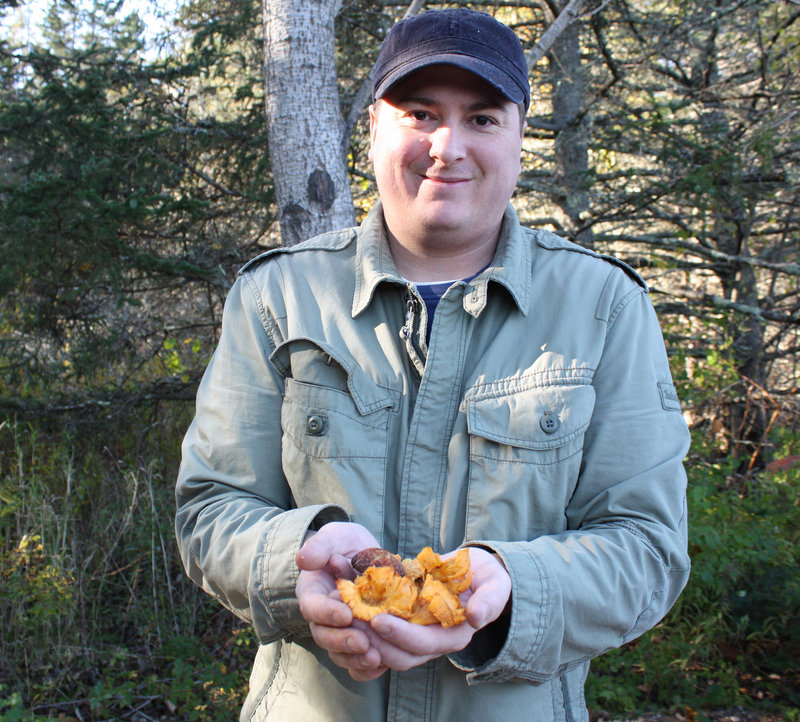On a crisp morning at the end of October, chef David Ross and I step off a dirt road in Kennebunk and head into a forest dominated by pines and smaller hardwood. Our objective: To track down a few chanterelles and any other wild mushrooms we can find this late in the season. This trip will mark one of the last of the year for Ross, who is an avid mushroom forager and the owner of 50 Local in Kennebunk.
“Right now it’s getting cold and there’s not much left,” Ross said as we wove our way through the underbrush. “But the chanterelles are still here.”
No sooner had he said this than he spotted a cluster of chanterelles, which to the untrained eye looked almost identical to the golden leaves that covered the forest floor.
“I try and clean them while I can,” Ross said as he brushed dirt and debris from a chanterelle.
Ross is also careful not to overharvest or disturb the important mycelium, which grows underground.
“I cut the mushroom (at the base of the stem) and leave the mycelium in the ground,” he said. “This is called sustainable harvesting. After I pick it, I put the leaves back.”
This year has been a particularly productive one for mushroom foragers in Maine. Hurricane Irene coupled with significant rainfall created ideal conditions for fungi.
In fact, so many varieties of mushrooms have been pushing up from the ground that the Northern New England Poison Center reported a dramatic increase in mushroom poisonings this September in Maine, New Hampshire and Vermont. The figure rose from 28 in September 2010 to 63 this September.
While amateur foragers who collect for their own kitchens can on occasion become too adventurous when they don’t have a rock-solid identification, Ross takes no such chances.
“If you don’t know what it is, don’t eat it,” he said.
Ross has honed his mushroom foraging skills with help from his sous chef Jared St. Onge, who has studied mushrooms with noted mycologist Paul Stamets.
St. Onge would normally have been in the woods with us, but he was visiting California wine country during our foraging jaunt.
When Ross finds an interesting-looking mushroom he can’t identify, he collects a sample (being sure to place it in a separate bag from his edibles) to show to St. Onge. Or he takes a photo that he’ll place on an online wild mushroom forum to get feedback from other enthusiasts.
“Black trumpet, hen of the woods, chanterelles – I know what those look like,” Ross said. “All the rest, I run by Jared.”
When we came across a patch of honey mushrooms, Ross told me “people do like these, but they can give some people indigestion. It’s not the type of mushroom I’m putting in the dishes at work.”
In a similar vein, the discovery of a cluster of small, tan mushrooms prompts Ross to tell me they’re known by the catchall term of LBM, or little brown mushrooms. “Never eat LBMs,” he said.
“Once you know what (a particular mushroom) looks like and you’re comfortable with what it looks like, there’s no mistaking it,” he said.
Over the course of the season, Ross estimates that he and St. Onge have collected 30 pounds of mushrooms, which have been incorporated into 50 Local’s menus. Since it costs about $25 per pound to buy wild mushrooms from a forager, their haul represents a cost savings for the restaurant.
“Chanterelles are definitely my favorite flavor-wise,” Ross said. “The black trumpets are good, but they don’t hold up as well” when you cook them.
One of Ross’ favorite ways to use the foraged fungi is in a wild mushroom tagliatelle dish. Using the restaurant’s house-made pasta, the dish can accommodate a single species of mushroom or a variety. (See the recipe at right.)
After an hour’s walk through the woods, Ross had collected a handful of chanterelles and one painted suillus. It wasn’t as much as he was able to find earlier in the season, but it wasn’t bad for this time of year.
“This summer there were so many mushrooms, we couldn’t pick them all,” Ross said, recalling patches of black trumpets that spread as far as the eye could see. “That’s when the hobby becomes a job.”
Staff Writer Avery Yale Kamila can be contacted at 791-6297 or at:
akamila@pressherald.com
Twitter: AveryYaleKamila
Send questions/comments to the editors.



Success. Please wait for the page to reload. If the page does not reload within 5 seconds, please refresh the page.
Enter your email and password to access comments.
Hi, to comment on stories you must . This profile is in addition to your subscription and website login.
Already have a commenting profile? .
Invalid username/password.
Please check your email to confirm and complete your registration.
Only subscribers are eligible to post comments. Please subscribe or login first for digital access. Here’s why.
Use the form below to reset your password. When you've submitted your account email, we will send an email with a reset code.